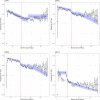Changes in on-time vaccination following the introduction of an electronic immunization registry, Tanzania 2016-2018: interrupted time-series analysis
- PMID: 36127683
- PMCID: PMC9485799
- DOI: 10.1186/s12913-022-08504-2
Changes in on-time vaccination following the introduction of an electronic immunization registry, Tanzania 2016-2018: interrupted time-series analysis
Abstract
Background: Digital health interventions (DHI) have the potential to improve the management and utilization of health information to optimize health care worker performance and provision of care. Despite the proliferation of DHI projects in low-and middle-income countries, few have been evaluated in an effort to understand their impact on health systems and health-related outcomes. Although more evidence is needed on their impact and effectiveness, the use of DHIs among immunization programs has become more widespread and shows promise for improving vaccination uptake and adherence to immunization schedules.
Methods: Our aim was to assess the impact of an electronic immunization registry (EIR) using an interrupted time-series analysis to analyze the effect on proportion of on-time vaccinations following introduction of an EIR in Tanzania. We hypothesized that the introduction of the EIR would lead to statistically significant changes in vaccination timeliness at 3, 6, and > 6 months post-introduction.
Results: For our primary analysis, we observed a decrease in the proportion of on-time vaccinations following EIR introduction. In contrast, our sensitivity analysis estimated improvements in timeliness among those children with complete vaccination records. However, we must emphasize caution interpreting these findings as they are likely affected by implementation challenges.
Conclusions: This study highlights the complexities of using digitized individual-level routine health information system data for evaluation and research purposes. EIRs have the potential to improve vaccination timeliness, but analyses using EIR data can be complicated by data quality issues and inconsistent data entry leading to difficulties interpreting findings.
Keywords: Digital health intervention; Electronic immunisation registry; Interrupted time-series analysis; Routine health information system; Vaccination timeliness.
© 2022. The Author(s).
Conflict of interest statement
The authors declare that they have no competing interests.
Figures






References
-
- World Health Organization. WHO guideline: recommendations on digital interventions for health system strengthening. Geneva: World Health Organization; 2019. - PubMed
-
- World Health Assembly . Seventy-first world health assembly- digital health, agenda item 12.4. 2018.
-
- The Bellagio eHealth Evaluation Group. Call to action on global eHealth evaluation: consensus statement of the WHO global eHealth evaluation meeting. Bellagio: World Health Organization; 2011.
MeSH terms
Grants and funding
- OPP1042273/Bill and Melinda Gates Foundation
- OPP1042273/Bill and Melinda Gates Foundation
- OPP1042273/Bill and Melinda Gates Foundation
- OPP1042273/Bill and Melinda Gates Foundation
- OPP1042273/Bill and Melinda Gates Foundation
- OPP1042273/Bill and Melinda Gates Foundation
- OPP1042273/Bill and Melinda Gates Foundation
- OPP1042273/Bill and Melinda Gates Foundation
- OPP1042273/Bill and Melinda Gates Foundation
- OPP1042273/Bill and Melinda Gates Foundation
- OPP1042273/Bill and Melinda Gates Foundation
- OPP1042273/Bill and Melinda Gates Foundation
- OPP1042273/Bill and Melinda Gates Foundation
- OPP1042273/Bill and Melinda Gates Foundation
LinkOut - more resources
Full Text Sources
Medical

